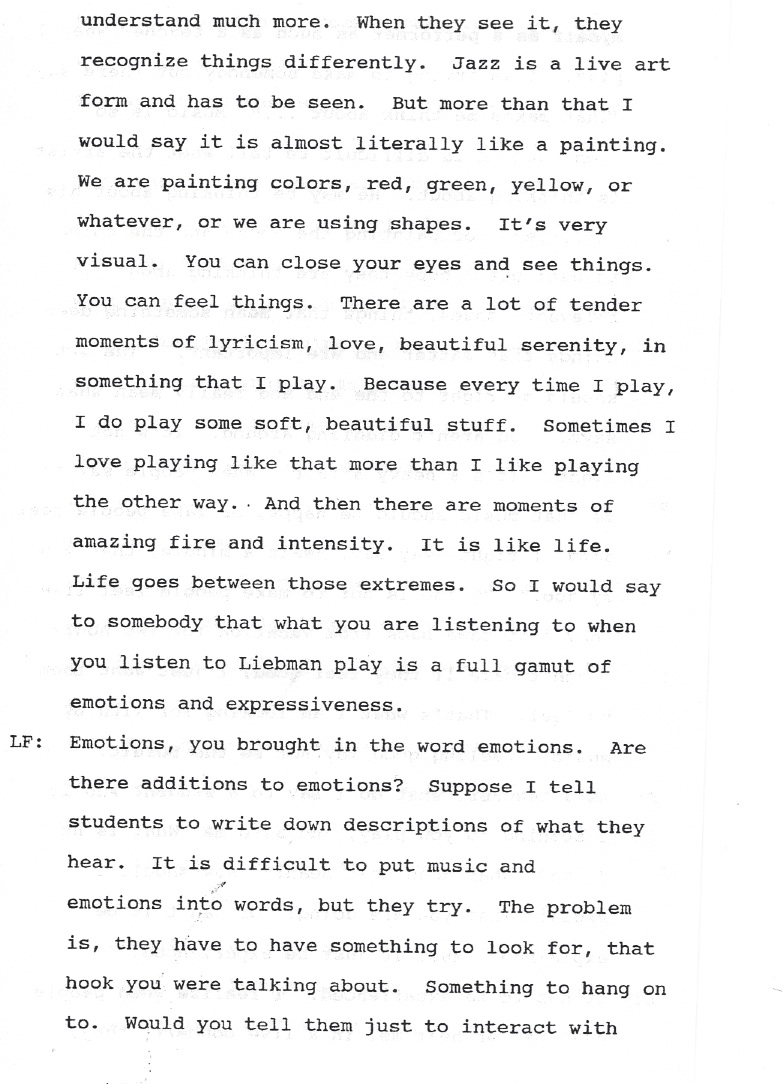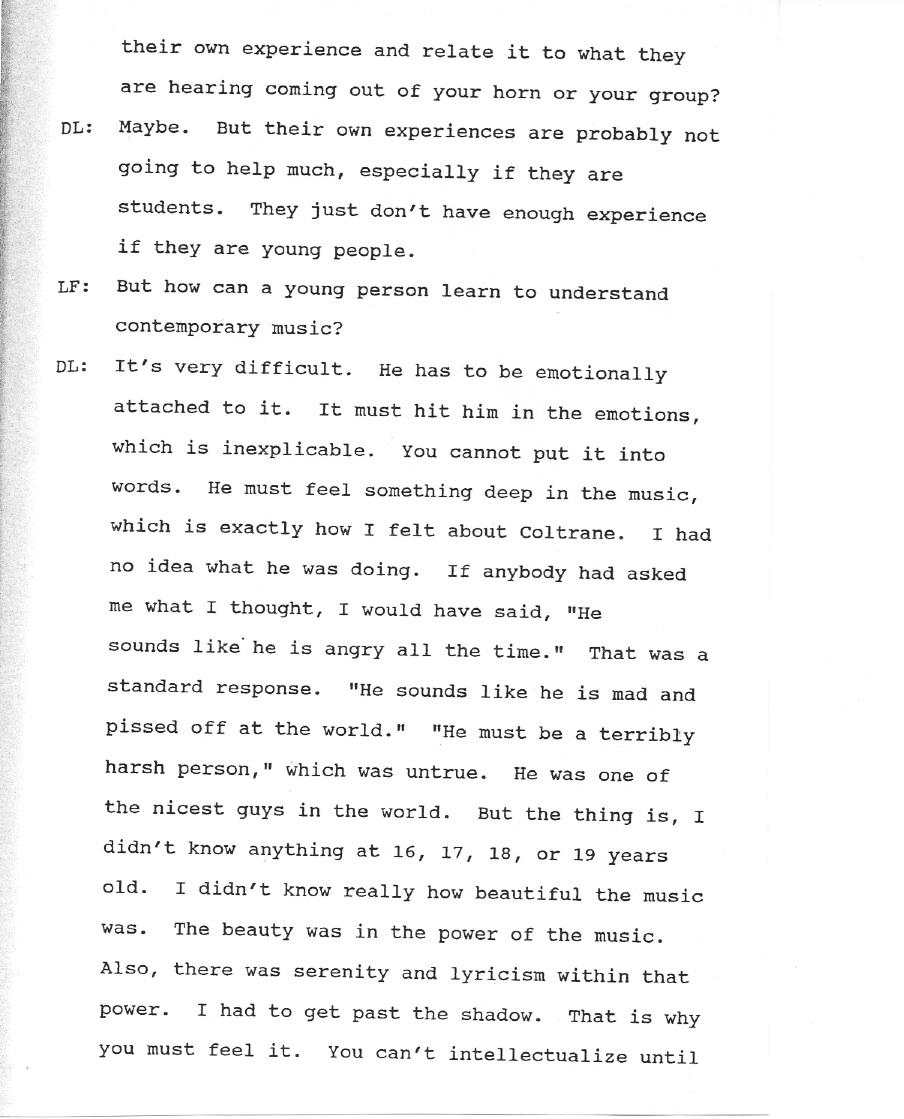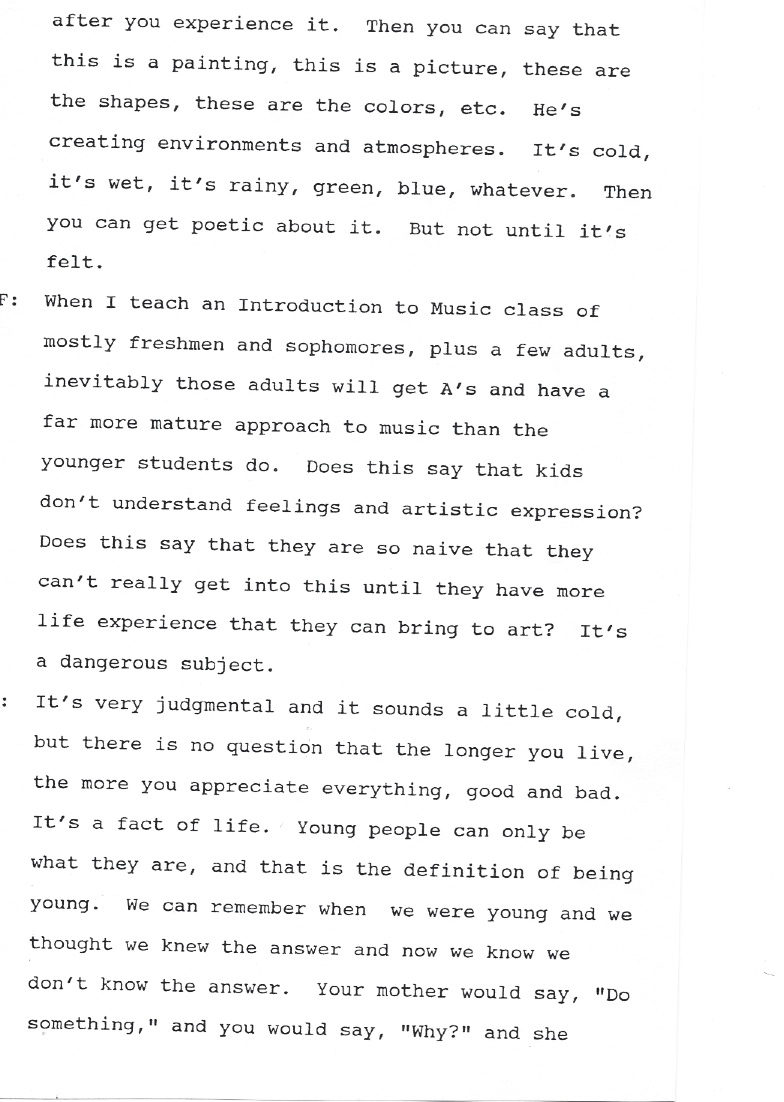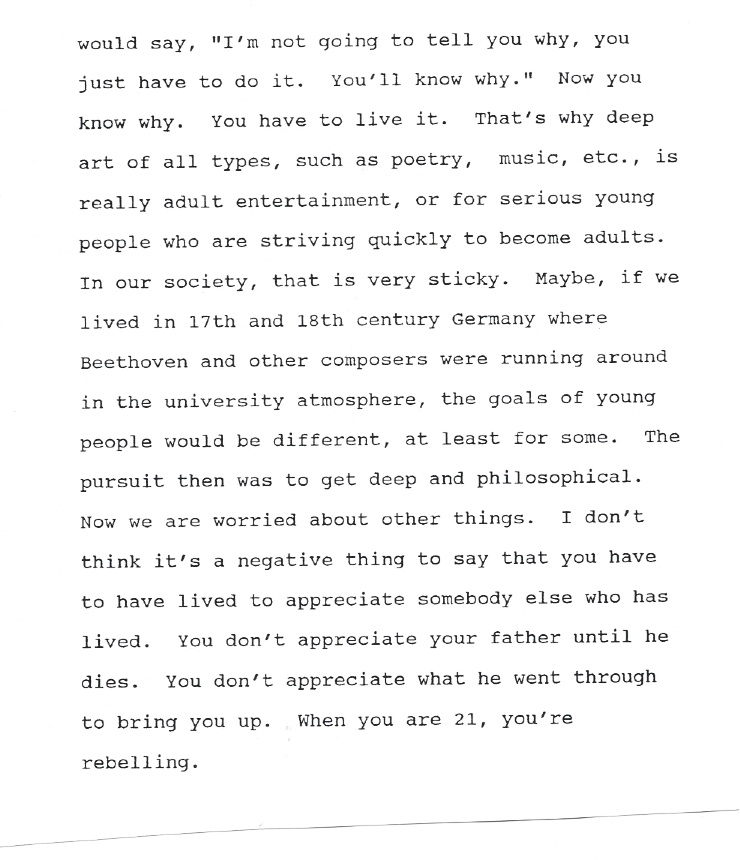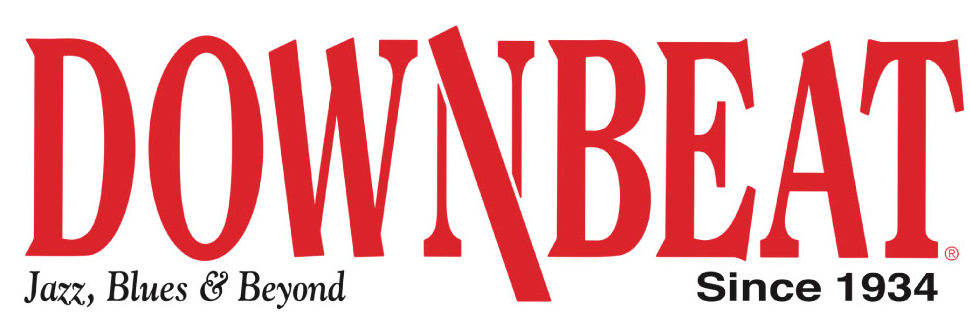Before and After
Dave Liebman
Blindfold Test for JazzTimes by Bill Milkowski
A singular saxophonist and renowned educator, Dave Liebman has been pursuing an adventurous, uncompromisingly creative path since the late 1960s. Originally inspired by seeing John Coltrane perform live, the Brooklyn native later studied with Lennie Tristano and Charles Lloyd before forming the Free Life Communication cooperative during New York’s vital loft jazz scene of the late 1960s. Following a stint with jazz fusion pioneers Ten Wheel Drive in 1970, he served apprenticeships with Elvin Jones (1971-73) and Miles Davis (1973-74). Liebman led his own groups in the early ‘70s, including Open Sky Trio (featuring drummer Bob Moses) and Lookout Farm (featuring pianist Richie Beirach and tabla player Badal Roy). His Dave Liebman Quintet of the late ‘70s included guitarist John Scofield. Following a world tour with Chick Corea, he reunited with Beirach in 1981 to form the Quest quartet with bassist George Mraz and drummer Al Foster (and later bassist Ron McClure and drummer Billy Hart). Liebman disbanded Quest in 1991 and formed the first incarnation of the Dave Liebman Group with pianist Phil Markowitz, which lasted through 1997. Guitarist Vic Juris then replaced Markowitz to assume the role of chordal accompanist and second soloist in the band. Their latest recording (with drummer Jamey Haddad and bassist Tony Marino) is In A Mellow Tone , released in April of 2004 on the ZoHo label. In 2002, Liebman also began touring in a saxophone summit with Michael Brecker and Joe Lovano, augmented by the world-class rhythm section of Cecil McBee on bass, Billy Hart on drums and Liebman’s longtime colleague Phil Markowitz on piano. Their first recording together, Gathering of Spirits, was released in August on the Telarc label. Liebman is also the founder and artistic director of the International Association of Schools of Jazz, an organization dedicated to sharing the joy of jazz worldwide.
1. Walt Weiskopf Nonet
“Outsider” (from Song For My Mother, Criss Cross Jazz). Weiskopf, tenor sax, composer, arranger; Recorded in 1995.
BEFORE: Yeah, beautiful chart. Great writing. I have no idea who it is but it’s beautiful writing and a great saxophone player.
AFTER: Oh, it’s Walt! I know Walt. He sounded great soloing. I liked the piece…kind of big band-y, but not. Of course, saxophone heavy, obviously. Nice flow in the writing, melodically switching between the instruments seamlessly. I really liked the ensemble writing in the beginning. I thought the chart went on a little long and maybe you didn’t need all those solos, but that’s just a matter of taste. On a live gig, yes, but for a record I would’ve shortened it up a little bit. Because the writing was the best thing about it, and his playing. His soloing was great. Walt is a well educated musician who knows what he’s doing and you can hear that in his playing. Also his sound very unique. It cuts through, which is very good for this kind of situation because you can really hear it over the section. I enjoyed it very much.
2. Johnny Griffin
“All The Things You Are” (from A Blowing Session, Blue Note). Griffin, tenor sax; John Coltrane, tenor sax; Hank Mobley, tenor sax; Wynton Kelly, piano; Paul Chambers, bass; Lee Morgan, trumpet; Art Blakey, drums. Recorded in 1957.
BEFORE: Now, did Trane make a record with a couple horns? I’m not sure if it’s Paul Quinichette, maybe Mobley. Anyway, for sure, Trane is the second sololist here. First cat sounds like Johnny Griffin but the vibrato is a little heavier than normal. But the way he played was definitely coming out of that Lockjaw-Griffin school of burning, tongued-every-note, amazing technical, arpeggiated, killing tenor playing. Very straight ahead note-wise, just right on the chords and very diatonic in that respect, with really great saxophone playing. A little over the top for my tastes as far as aesthetic goes but nonetheless still great playing. And then Trane…it’s just so magical. He does everything here — the killing chops thing plus he does melody plus he hangs on the beat…so behind the beat for such a long period that you’re on the edge all the time, which is part of the thing of playing this music. I mean, when you’re going to play time, to me, if you’re not fooling around with the placement of the beat, you’re losing something that you could gain which is the mystery of where the guy is hanging on the beat. And that’s specially effective with a drummer who is playing in that straight ahead style like this guy. Is it A.T. (Art Taylor)? Trane is really playing great on this. He does a long eighth note thing. The trumpet player I don’t know, nothing special to me. And the last cat sounded like Hank Mobley with a little brighter sound and something a little different…but it does have a lot of Hank in it. Great melodies and very smooth, very creative within the harmony. That’s one of Hank’s great trademarks. I think he was one of the most sophisticated players.
AFTER: There’s another one with Paul Quinichette and Gene Ammons that Trane is on (Groove Blues, Prestige, 1958). At first I thought this could’ve been that.
Well, that didn’t strike me as Lee (Morgan) for some reason. But Trane is obvious here. He was the voice then. What year would this have been? I mean, he’s so sheets-of-sounded out there. This is around the time of Blue Train and this is just when he’s starting to get that aspect of his playing together. He’s really starting to tighten his shit up from ‘55-56, when he was playing with Miles. Now, by ‘57, he’s getting his shit together bigtime. And the sound and the vibe and his choice of melody versus speed was, I think, a very big innovation at that time. What he created harmonically and yet lyrically in the course of a solo was…I mean, outside Sonny (Rollins) who did it in a different way…was really unheard of. And you can hear it on this solo. It’s fantastic. This tune being an old warhorse, it’s a great thing to hear. I mean, what do you do after Johnny plays like that…the cat devastates the horn and tongues every note…you can only do your thing and just imply more than state. And Trane is great at that. Hank too. Hank sounded fantastic here. Nice record. Three very distinctive voices on the tenor sax. I have to remember this in light of what we’re doing with Mike and Joe. This is very much in that respect…three different voices converging on the same tune.
3. Stan Getz, Zoot Sims, Al Cohn, Allen Eager, Brew Moore
“Battle of the Saxes” (from The Brothers, Prestige). Getz, Sims, Cohn, Eager, Moore, tenor saxes; Walter Bishop, piano; Gene Ramey, bass; Charlie Perry, drums. Recorded in 1948.
BEFORE: Well, that was very different in a lot of ways. First of all, I couldn’t tell you the difference between who was playing. I don’t even know if it was three guys or four guys. There was such a similarity of approach and sound, such a sameness about it that I couldn’t tell who was who. It’s so Pres-ed out. I’m sure these guys, whoever they are, would just kiss the feet of Lester Young. It’s so influenced by him in every way — all their sounds have that veiled almost misty quality, like a blanket put over the tenor sound. It’s a beautiful sound in that respect and they all articulate similarly, which is not a very hard articulation, it’s very legato. And most of all their rhythm and choice of notes is so diatonic and lyrical, meaning melody above all. And their choice of pitches are the same…all the good, pretty notes. Not too many passing tones, which is very different from what we heard before. Right there is the summary of what Lester Young’s contribution to jazz was. Maybe that’s the sax section with Woody Herman, I don’t know. It’s one of those put together things…I could not tell you who they were but they all had a very similar approach for sure.
AFTER: It’s those guys! It’s the section. I wouldn’t know who was who but it’s all those cats, definitely, at that time period. I mean, this is like them absorbing the influence of their main guy, and you can really hear it. And one other thing, when you figure that it’s 1949…to have Bird and to have Lee Konitz and Lennie Tristano doing Intuition, and then to have these cats…you got three major approaches to the saxophone right there. And this was a great example of that Lester Young tradition. I mean, I was never attracted to this personally as far as my own feeling goes but I have a lot of respect for it and these guys really hit the nail on the head for a certain way of playing, no question about it.
4. Paul Motian
“Skylark” (from On Broadway, Vol. III, JMT). Motian, drums; Bill Frisell, guitar; Joe Lovano, tenor sax; Charlie Haden, bass; Lee Konitz, soprano sax. Recorded 1991.
BEFORE: I’ll betcha it’s Frisell, and it sounds like Joe (Lovano) on tenor. And that means that it’s Paul (Motian) on drums. It’s that group Paul has. Soprano? I don’t know who the hell that is. It’s nice, real nice. He’s got a different sound. The thing that’s interesting about this in light of what we heard…We heard the blowing session with Johnny Griffin, who is coming out of, in a sense, Coleman Hawkins. Then we heard the white brothers playing Pres. And now this approach here, in a certain way, is almost coming out of that Pres thing too. Of course, Joe is a little more sophisticated than the soprano player harmonically, but it’s still coming out of that melody thing and playing very close to the melody, Frisell stays very close to the melody…didn’t play much. In that way, it’s very convincing. I mean, that’s a beautiful tune. There’s nothing you have to do on a tune like that. Just play the damn tune and that’ll take care of itself. But Joe sounds beautiful on it. That’s what Joe does so well.
AFTER: That’s Lee? I’m very impressed. I thought they had done a record together. Lee sounds beautiful on it. You would never really think it was Lee because it doesn’t sound like his alto playing, approach-wise. I gotta tell him when I see him, I was very impressed. It’s great to hear. What a great voice. I never heard him play soprano before. When a cat picks up a horn that he doesn’t play that much it’s very interesting to hear. It’d be like me playing alto. You know, because it’s something you don’t really do and the question is, what would you do on it? Is it an extension of your voice? Is it something completely different? In this case, boy, that sounds different than I would ever associate with Lee. And it’s beautiful playing, really gorgeous.
5. Branford Marsalis Quartet
“Lykief” (from Requiem, Columbia). Marsalis, soprano sax; Kenny Kirkland, piano; Eric Revis, bass; Jeff “Tain” Watts, drums. Recorded in 1998.
BEFORE: Well, this is one of those cases of dressed up and no place to go. Lot of smoke, no fire. What do they do after this, these cats? The soprano player’s got a lot of chops. Everybody’s got a lot to say, they have one arc, which is start here and go there. Day and night shapes. It’s the way we used to play in the late ‘60s. That was the thing, you had life and death, black and white, calm and crazy, air and then dense…extremes in one tune. But what would they do after this or before this? That would depend on the record maybe. The other thing is, this is what I call triadic Appalachian madrigal English folk song…sort of Ornette-ish but not as catchy in a way. In other words, triadic, churchy, harmonically not really too much to do so you fill it with other stuff, which they do very well in that respect. But there’s not much to go on. Long, long head, very extended and then they don’t really play anything from the head. Playing like this is hard in a way because there’s not much to go on. You gotta be very artistic to make a statement that holds water on repeated listening. Now, in a little club or something like this we’d be very happy hearing this. We’d have a nice night, we’d have a beer, we’d feel good and it would be fine. But on a record for it to hold up it has to have a little bit more of a shape, I think…again, depending what else is on the record. But the soprano player is chopped out…some serious technique. I mean, way over the top. He doesn’t need that much to play what he’s playing here, but he sounds very good. I have no idea who it is. Could be anybody. Could be European cats but it’s almost a little too slick for that.
AFTER: That’s Branford? I would never think that was Branford. His chops sound very good but I don’t identify him with playing like this in general. Maybe that’s the reason it’s done in such extreme swaths. In other words, it’s not too subtle a message. Again, it depends on what else is on the record. There’s always room for a track like this. But would they play like this all the time, is this the way they play or is this their one-time shot at playing in this style? Because guys who play in this style usually have some mid-range stuff, which this didn’t have. But his technique is flawless, that’s for sure.
6. Lucky Thompson
“Beautiful Tuesday” (from Lord, Lord Am I Ever Gonna Know?, Candid). Thompson, soprano sax; Martial Solal, piano; Peter Trunk, bass; Kenny Clarke, drums. Recorded in 1961.
BEFORE: The soprano’s rough to keep in tune, man. That’s for sure. You know, you’re putting a lot of air in a small space, the mouthpiece is small, every move is critical…a move of an inch is a yard. It’s like the oboe, in a way. When you’re putting that much airstream into that small neck before it gets out of that botttom, everything’s critical. That’s why soprano is so difficult. So you really gotta watch your high notes, no question about it. This guy is slightly out of pitch, but it’s OK. It’s not that bad. He sounds like a guy who plays soprano as a doubler. In other words, Lee (Konitz) had a different voice on the soprano. He didn’t play it like he plays alto. This guy is playing it like he could be playing tenor or alto. Just conceptually he plays those kind of lines, which is fine. I’m not putting a judgment on it. Nothing remarkable about this. Nice interesting tune for this kind of bebop style. It sounds a little more interesting than usual.
AFTER: Oh yeah? See, Lucky was one of the first ones to play soprano. He’s right up there with Lacy, although he didn’t make a big thing out of it that we would know him for that. But Lucky is one of the cats who played soprano and brought it out early on. I wouldn’t be that familiar with him to say that that was Lucky Thompson but it sounded like a cat who was playing soprano as a tenor player, which would’ve been the way in those days. Steve (Lacy) is another story because he played clarinet and he played Dixieland, so he had a voice right away on the soprano. But both Trane and Wayne, you really gotta give it to them for ascerting that this is not just a double instrument, it’s another instrument so therefore another voice and therefore another way of playing. And that was really remarkable in that day and age not to have it just be a duplication of your style on another instrument. That was rare, at that point, in the early ‘60s. Now, of course, you’re expected to do that. But in those days, that was remarkable. Especially Trane. I mean, in ‘61…that’s Trane already.
7. World Saxophone Quartet
“Try A Little Tenderness” (from Rhythm And Blues, Elektra Musicians). David Murray, tenor sax, arranger; Oliver Lake, alto sax; Julius Hemphill, alto sax; Hamiet Bluiett, baritone sax. Recorded in 1988.
BEFORE: I mean, this band made a contribution, no question about it because who would put a saxophone quartet together like that? I mean, white guys wouldn’t do that, they would get it perfect. These guys have a nice attitude towards it, it’s churchy and stuff…I can go with that. But the performance was just not together. I don’t know if you don’t have enough time to do other takes or not, but the downbeats aren’t together here. Maybe there’s a calculatedness to it that they like. I never really go for this kind of stuff in general because I think it’s a little too obvious what you’re trying to do, voicing-wise and everything. It’s one of those older pop tunes, a nice tune. So in that way the voicings fit for what they’re doing. But there’s just a certain thing that I just look for when I hear somebody play, and it’s beyond style because it doesn’t matter if it’s inside, outside or whatever. It’s a certain amount of control over what you’re doing. And control means…again, notwithstanding stylistic differences, I mean, but if you’re going to play a flurry of notes and you’re going to play up and down and stuff like that, there’s a certain amount of cleanness on the beginning and end of a phrase that, to me, should be apparent somewhere. If it’s not for too long then I start to be a little bit disappointed in the performance. If this was a student I would stop the tape and say, “Where was your beginning, where’s you end, where’s your articulation? Maybe I’m not following your thought. Could you show me where the thought ends and begins? Maybe it’s beyond my hearing, I’ll admit that. But let’s go there and put a frame around it, because everything needs a frame in music.” I mean, you need some kind of frame. It could be long, long breaths and long frames, but you need a frame. This kind of playing sometimes to me feels like he’s turning the engine on and just going full-throttle without a pause. And there’s a place for that and certainly there’s people who love that and respond to that because of the energy level. But I’m not sure how much artisticness there is in it. And to me, after a while, it just gets to sound the same. That’s the way I hear it.
AFTER: Those cats, as much as I like some of them individually sometimes they seem to go there a lot, to me. We played opposite them once and I felt the same way. So that’s my feeling about that. But look, they made a big splash because they did things that other cats wouldn’t have done in a saxophone quartet, because usually it comes out of the classical tradition — it’s very clean, it’s very clear. When I do saxophone quartets it’s accurate and all that stuff. And this is like saying, “OK, let’s go.” On that level I can dig it.
8. Joe Lovano
“Eternal Joy” (from Trio Fascination: Edition One, Blue Note). Lovano, soprano sax; Dave Holland, bass; Elvin Jones, drums. Recorded in 1997.
BEFORE: Well, if that’s not Elvin it’s somebody who sure sounds like him. It’s very nice because Elvin’s not playing eight bar cycles, it’s a very open Elvin. This reminds me of the Puttin’ It Together record (Blue Note, 1968) with Joe Farrell, but that’s not Joe, I think. But it reminds me of the original trio when Elvin left Trane that preceeded my time with him. A lot of Joe Farrell influence there, a lot of pattern-type playing. Good soprano playing. I wish he would leave a little more space, especially when you’ve got Elvin. Is that Dave Holland? If you got that under you…especially a guy like Dave who is smart and knows what to do and when to do it…if you leave more space I think you’re gonna get a better effect on your solo. Maybe that’s the moment. It’s hard to hold back sometimes. Is that Joe Lovano on soprano?
AFTER: I’ve heard Joe play soprano but he’s got a lot of Joe Farrell in his playing on this. I’ll have to tell him that when I see him. What’s nice about it is he’s floating through it, keeping the thing going and they’re just circling around without any bar. The other record that’s really great for that is New York Is Now and Love Call. Those two records with Ornette, man…to me, that’s the top of the line for Ornette, along with the Golden Circle Stockholm recordings (with drummer Charles Moffett and bassist David Izenzon, Blue Note, 1965). The way that Ornette plays causes Jimmy and Elvin to circle around. The other Elvin record like that is On the Mountain (PM Records, 1975) with Jan Hammer and Gene Perla. If you got Elvin in the right situation, he didn’t have to mark off eight-bar forms, he could roll through it like no one else could, which would create an undercurrent for you to play over. And this track gets him to do that nicely. I enjoyed that man. It’s great to hear Elvin. Of course, when you give him a riff at the end and let him just go with something like that and just let it happen…that’s what he could do like no one else. That’s his thing, that’s where he comes from. And it was also nice to hear Elvin playing so softly behind Dave’s solo. He’s the greatest example of controlling dynamics from top to bottom that I’ve ever known. That’s one of Elvin’s great contributions, dynamic range.
9. Steve Lacy
“Shuffle Boil” (from The Rent, Cavity Search). Lacy, soprano sax; Jean-Jacques Avenel, bass; John Betsch, drums. Recorded in 1997.
BEFORE: Yeah, Elvin and Lacy…the dearly departed. It’s been a bad month, man. Lacy’s contribution will live on forever. I never really directly copped anything from him for myself, musically, except just his honesty and straightforwardness. And one thing about Lacy…no matter what he played, whether it was with a Russian poet or some koto shit or Monk or his quartet or whatever, he always sounded the same. He transcended all styles and he was not adversed to trying them, as we know, everything. And he always sounded like him, which is very slow, methodical, mostly eighth notes. Sound above all. Very thoughtful. And very much like his personality in the respect that he was a master of the one-liner. Like, if you asked Lacy a question or would say something to him, he responded with, “Yes, exactly.” Very economical, no explanation needed. And the way he played was the way he was…very economical, no excess, no fat on the meat, absolute filet mignon only, right down to the medium rare. And for that I’ll always respect him, for his thoughtfulness and his economy and sincerity. Because Lacy was a great example of artiste, period. We did some solo and duo things together in a church in Italy once. He’s a master of the solo horn. I mean, to get up and do that in front of an audience…piano’s one thing, guitar…maybe, but to get up there with a soprano saxophone and play an hour and a half and make it a trance and get you into it…that’s Steve. Braxton too, of course, but Steve moreso in a way because it’s so concentrated. He was like that Japanese painting style…that one-stroke shit. Cats put the black water paint down on parchment in one stroke…boom…one after another. Lacy was like that, very direct communication. What it is is what you got, nothing more. That’s what it was. Yeah, he was something else, man. And he also had a unique setup — big opening with a small reed. 12 opening or a giant F, H, Z opening on Selmer and a #1 reed, which is like an unbelievable combination. Which enabled him to do what he could do. Because you can control the reed but you really have to be at a certain level of intensity. I couldn’t play his setup at all, but you know, guys can’t play mine either. That’s part of what it is. But he had a very unique thing. And then, of course, going to one instrument and staying on it and not switching around, which you know I did for 15 years with the soprano…I think that’s important and he’s an example of that. He just stayed there from 1960 on, and therefore mastered it and became its friend. That’s to be respected.




